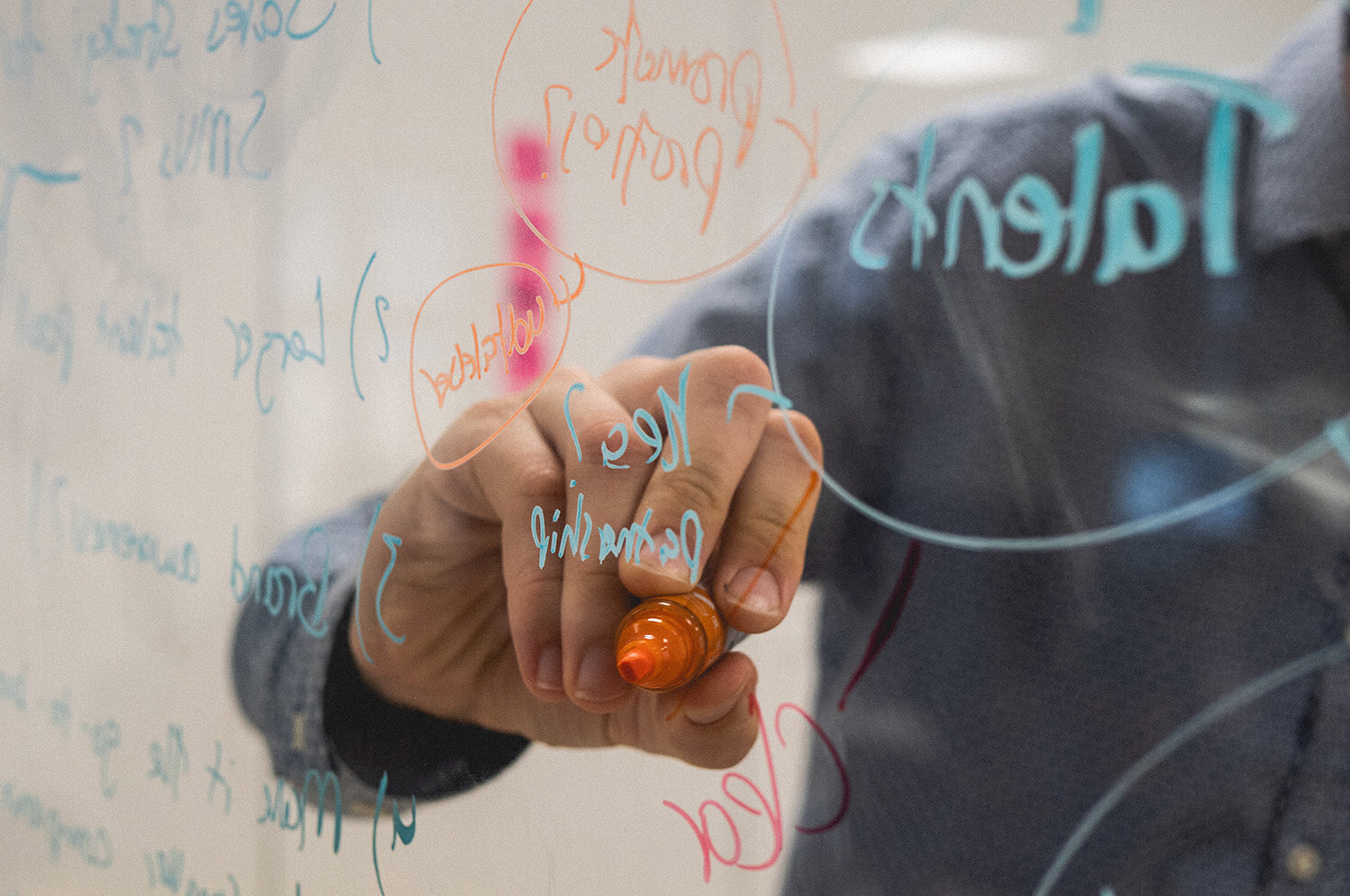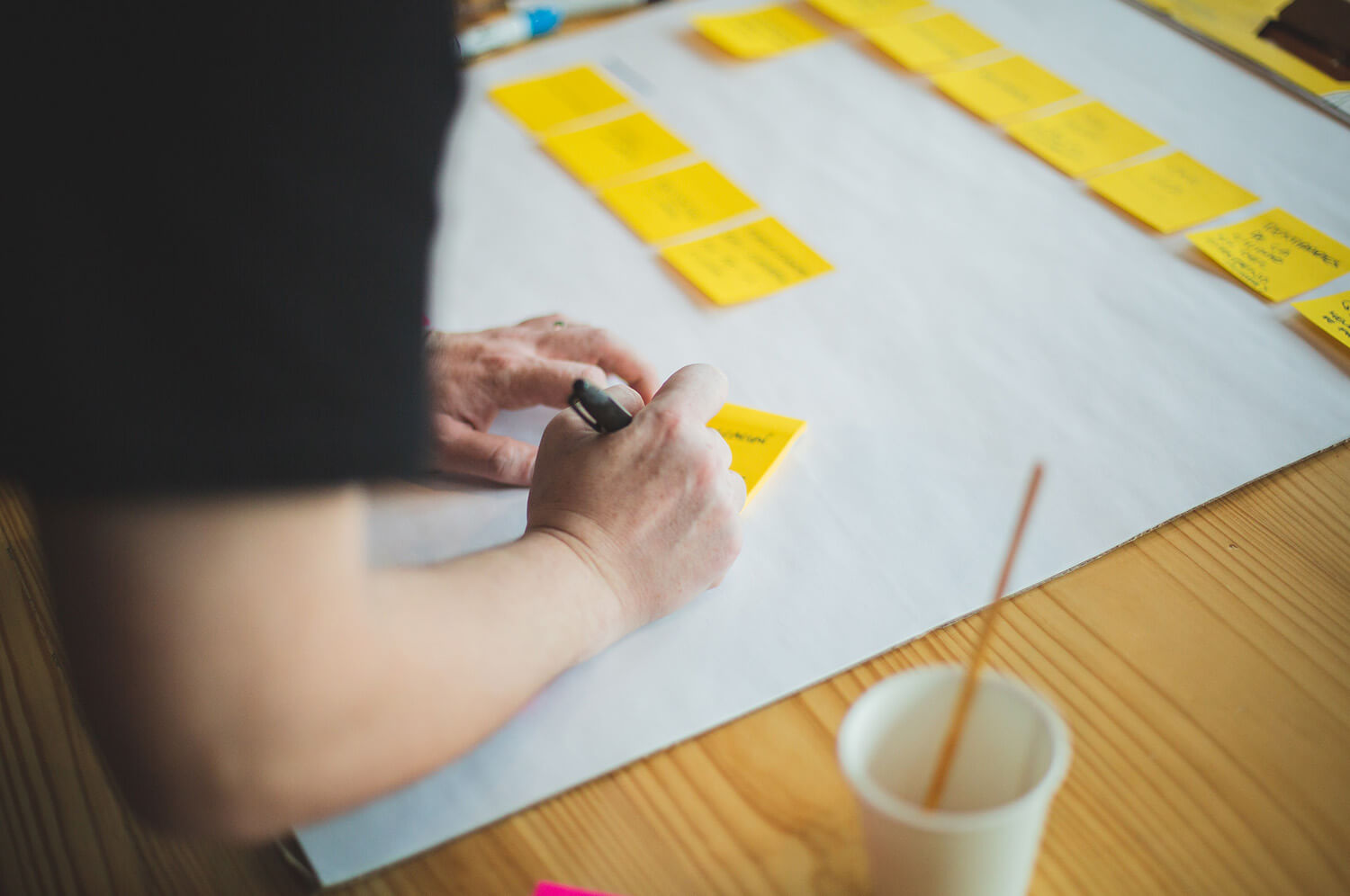From this article, you'll learn what a product design workshop is and why it's so beneficial to start your next project with one. We also list some of the most common questions that are discussed during the workshop.
Designing a digital product from scratch is a relatively complicated process. Whether it’s a new mobile app or custom software for internal use, it’s pretty much unavoidable that the developers will face various risks and problems during the development phase. And if a client comes to the software house with only a vague vision of the final product, jumping straight into the development phase can quickly turn the process sour.
How can the vision be shaped into a tangible product? One of the best ways to do so is by having a product design workshop (also known as discovery workshop) for the development team and the client. During those meetings, both parties can share information about what needs to be done to finish the product successfully, pinpoint potential project risks and challenges, plus estimate how much time and resources they realistically need. All of this in order to steer the project in the right direction.
Is it the first time you’ve heard about product design workshops? You are in the right place! In this article, you’ll learn what product design workshops are and why starting your next project from one is definitely worthwhile.
What is a product design workshop, and why is it so important?
A product design workshop is one or several meetings during which all interested parties (meaning the client, project manager, and development team) will discuss and clarify various details of the project to ensure they are all on the same page.
During discovery workshop meetings, the development team will talk over all topics and questions that are important for the project: from client’s needs and expectations to technical requirements, design ideas, and potential risks that might be encountered during the development stage. If the developers have any questions for the client or suggestions about how the scope could be improved, those can also be clarified during the meetings.
That leaves the product owner with full knowledge about how the project is expected to proceed and the development team with a clear and detailed action plan up to the completion of the project. Through product design workshop meetings, the development team can also:
• Define the purpose of the project and set SMART goals and deadlines
• Outline the main features and functionalities of the end product
• Specify the target audience of the product
• Estimate the project timeline and budget required for it to be completed successfully
• Create a Product Specification Document to streamline the project
• Discuss all potential challenges and risks that might be faced

Basically, product design workshops are intended to help the development team gain as much information about the project as possible and understand the businesses’ (and its customers’) needs in order to build solid foundations for the development stages of a product.
A detailed analysis of the whole project that is carried out before starting the development stage will also help the team avoid (or minimize) wasting time on fixing unexpected issues or going far over the budget due to “scope creep”, i.e. the project growing far beyond the initial requirements.
What are the main benefits of product design workshops?
1. Helping the development team understand their clients and project requirements
One of the biggest reasons why a software development project might fail is because of little to no actual understanding between the developers and the client. The cause for this is usually very simple - poor communication. A client might incorrectly assume that the software development team knows straight away what they expect from the product and doesn’t provide detailed enough guidelines for the team. The clients know precisely what their main goals are, for what they are planning to use the product, and how it should fit into their strategy. For them, it is so obvious that they might forget to tell these crucial things to the software development team.
During discovery workshop meetings, both the developers and clients can ask questions, clarify information, and share their ideas or suggestions for the end product. This way, software team members can learn more about the client and adjust the scope of the project until the client is satisfied and the team knows exactly what to do. If there are any misunderstandings between the client and any team members, they can also be resolved straight away without wasting time during the later development stages.

2. Opportunity to verify the main idea behind the project
Getting into the design stage while only having general product documentation and a brief list of functionalities without testing the idea first might result in several problems suddenly arising. For example, a core feature turns out to be much more challenging to implement as it requires other functionalities not mentioned in the scope. At this point, searching for a workaround or changing the scope can jeopardize the entire project.
During discovery workshops, developers can carefully check the project guidelines and verify whether or not it is even possible to complete the project according to a given time and budget with the end-product meeting the needs of the client (and future users). This is also an excellent time for all team members to suggest changes or improvements to the initial project - for example, if they know that a given aspect could be completed faster and more easily using a different method or if they think that a particular feature isn’t necessary for the end-product.
3. Brainstorming new ideas
Sharing ideas and feedback between the client and the development team doesn’t just help clarify the requirements for the product, but it can also lead the team to find a fresh perspective on it. As brainstorming requires a group of people to think creatively about an issue, share their ideas and comment on others’ suggestions, it can lead the team to find a much better way to solve a challenge or tackle a task than initially planned and pick the best solution together.
4. Discovering the project’s risks and weak points
The bigger and more complex a project plan is, the greater the risk that things might go awry during the development stage. The core elements keep crashing, the prepared tool stack is nowhere near sufficient, or more team members are needed to get a feature working and so the budget turns out to be severely underestimated.
During the planning and testing stage of the discovery workshops, all those potential difficulties and risks can be spotted early on. This gives the development team enough time to either prevent the issue from appearing entirely, plan a workaround strategy, or suggest a way to minimize the impact of the problem.
5. Better time and budget estimations
Correctly estimating how much time will be needed to build custom software and how much it will finally cost is one of the biggest challenges both for clients and software development teams. Even if a project seems to be well-defined, a single change to the scope or one unexpected issue can quickly throw the schedule into disarray and rack up costs. Tight and rigid deadlines will also create a lot of stress and frustration among the development team, and are bound to cause things to go wrong.
With product design workshops, software development teams have enough time and data to analyze the project in detail, plus count the approximate time and money needed for each stage of the product. This can both prevent “scope creep” from occurring and also allow the team to set realistic deadlines for each stage.

6. Getting to know the team
The last benefit of discovery workshops is that you can get to know the whole team who will be responsible for designing and developing your product. You can spend time discussing all of the ins and outs of your new product with the project manager, work together with the UI and UX designers, as well as ask the front and back end developers additional questions. Through these workshops, you can also see for yourself how the team works together and their attitude towards the project.
What are some questions you might be asked during product workshop meetings?
The following is a list of potential questions that may be asked during various stages of discovery product workshops:
A strategic overview
▸ What are the objectives of this engagement?
▸ Is there any client proposition associated with it?
▸ Is it possible for us to evaluate the success of the project together?
▸ When we conclude the engagement, how will we ensure the business objectives are achieved?
▸ What makes this project stand out from the competition?
Overall UX
▸ Which audience is it aimed at?
▸ What is the demographic profile of the client's audience?
▸ Where will the needs of users who intend to use the solution differ?
▸ What can be done to improve customer satisfaction?
▸ How do we build the application?
▸ What devices will the app support?
Content approach
▸ Are content strategies included in the scope of the project?
▸ How do we categorize our content?
▸ Is there any plan to migrate old content and, if yes, how to do so?
▸ What is the default language for the solution, and how will language selection requirements change depending on the user journey?
Design requirements
▸ Is there a style guide or brand collateral?
▸ Brand book: how well defined is it?
▸ What level of flexibility does our company have in terms of existing style guides?
▸ Can the client already visualize designs in their mind?
Features list
▸ Will there be any integrations with social networks?
▸ What third-party integrations do the clients expect?
▸ Are multilingual solutions expected?
▸ What is the client’s role in using the functionalities and features to improve the project’s business results?
▸ Is it necessary to capture data?
Safety reasons
▸ Does encryption have to be used?
▸ Is there a legacy system in the client's company that needs integration?
▸ Are tracking tools expected by the client? If so, which tools should be used?
▸ How will it be hosted?
▸ How will backups be handled?
Communication issues
▸ How are the stakeholders identified?
▸ Who is responsible for all client communication during project implementation?
▸ Would the client be comfortable adopting agile methodology?
▸ Which communication channels and tools are preferred?
▸ What role does communication play in day-to-day operations?
▸ Who will oversee the Project Management process?

Conclusion
When it comes to completing a project on time, on budget, and exactly as the client envisioned it, there’s no better way than starting with a product design workshop meeting. This will help your team not only gather plenty of information about the client’s needs, but also spot all places where something problematic might crop up and prevent it from happening.
And looking at how many new ideas you might have simply by exchanging views with your clients or team members, one of which may turn out to be exactly what the project needs in order for it to be completed faster and cheaper, having a product design workshop before your next project is definitely worthwhile. How about trying it out during your next project?
You may be also interested in:
➤ How to build an MVP. A Guide to Minimum Viable Product
➤ How to build a SaaS product? A beginner’s guide
➤ 6 common risks in software development projects – and how to avoid them











 Angry Nerds (Poland)
Angry Nerds (Poland) Angry Nerds (USA)
Angry Nerds (USA) Angry Nerds (Canada)
Angry Nerds (Canada)



